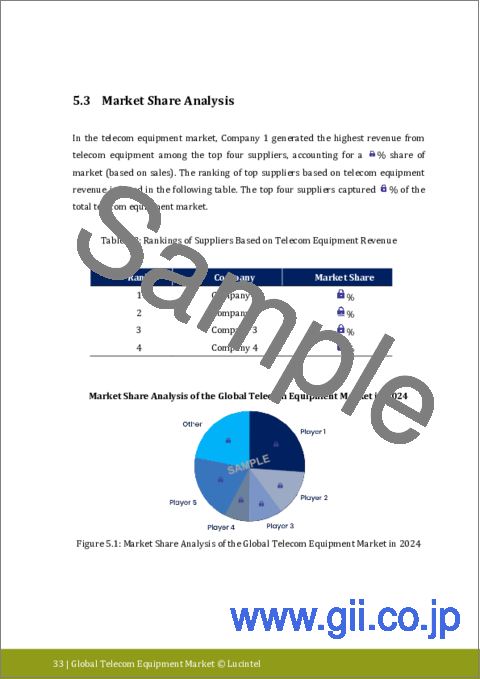|
|
市場調査レポート
商品コード
1617048
通信機器市場レポート:2030年までの動向、予測、競合分析Telecom Equipment Market Report: Trends, Forecast and Competitive Analysis to 2030 |
||||||
カスタマイズ可能
適宜更新あり
|
|||||||
| 通信機器市場レポート:2030年までの動向、予測、競合分析 |
|
出版日: 2024年12月02日
発行: Lucintel
ページ情報: 英文 150 Pages
納期: 3営業日
|
全表示
- 概要
- 目次
通信機器の動向と予測
世界の通信機器市場の将来は、BFSI、IT・通信、小売、メディア・エンターテインメント、軍事・防衛、ヘルスケア、コンシューマー・エレクトロニクスの各市場における機会によって有望視されています。世界の通信機器市場は、2024年から2030年までのCAGRが6.5%で、2030年には推定9,635億米ドルに達すると予想されています。この市場の主な促進要因は、モバイルユーザー数の増加、モノのインターネット、スマートインフラ、コネクテッドデバイスの普及の増加、そして世界中で5G技術への需要が高まっていることです。
- Lucintelの予測では、インフラストラクチャの中ではワイヤレスが予測期間中に最も高い成長を遂げる見込みです。
- 最終用途産業カテゴリーでは、民生用電子機器が最大のセグメントであり続けると思われます。
- 地域別では、北米が予測期間中に最も高い成長が見込まれます。
通信機器市場の戦略的成長機会
通信機器市場は、技術の進歩や市場からの需要により、さまざまな応用分野にわたっていくつかの成長機会を提供しています。
- 5Gインフラ:高速化、接続性の向上、さまざまなプラットフォームでの高品質なサービス提供、スマートシティへのモバイルサービスなどを可能にする5Gインフラへの投資が拡大する可能性があります。
- IoTコネクティビティ:大きな可能性を秘めた分野のひとつが、多数のデバイスやアプリケーションをシームレスに接続できるよう、モノのインターネット・サポートの拡大に対応する通信機器の開発です。
- ネットワーク・セキュリティ・ソリューション:サイバー脅威は増大しており、高度なセキュリティ技術を備えたデバイスが、より強固なネットワークとデータ保護をサポートできるようになる好機です。
- クラウド・ネイティブなネットワーク機能:クラウド・ネイティブ・ソリューションへの転換は、スケールアップやスケールダウンが可能な、よりダイナミックなネットワーク機能への道を開く。
- 持続可能なテクノロジー:グリーンでエネルギー効率に優れた通信機器に対する需要の高まりは、規制による圧力や生態系への懸念によってもたらされています。
こうした成長機会は、通信機器市場の投資パターンや技術開発に影響を与え、技術革新と拡大をもたらしています。
電気通信機器市場の促進要因・課題
電気通信機器市場には、特定の方向に成長する際に影響を及ぼす複数の促進要因・課題があります。
電気通信機器市場の促進要因には以下のようなものがある:
- 技術の進歩:5GやAIなどの技術革新の継続は、ネットワーク容量とサービス提供を強化する通信設備の改善需要を後押しします。
- データ消費の増加:より多くの帯域幅を必要とするデータトラフィックの増大は、関連機器を含むテレマティクス・インフラのアップグレードに関する投資決定につながります。
- 規制による支援:先進的なネットワークの活用に有利な政策とインセンティブが、発展レベルの異なる各国での導入促進に利用されています。
- 成長するIoTエコシステム:モノのインターネット(IoT)アプリケーションの普及は、様々なタイプの通信機器の必要性を生み出しています。
- スマートシティへの投資:スマートシティの構築により、高度な都市インフラや相互接続をサポートする通信機器のニーズが高まる。
通信機器市場の課題は以下の通り:
- サイバーセキュリティの脅威:サイバーセキュリティの脅威:増大するサイバー攻撃はネットワークのセキュリティとデータの完全性を危険にさらすため、通信機器には強力なセキュリティ対策が必要となります。
- 高額な設備投資:インフラのアップグレードや新技術の導入には多額の投資が必要であり、一部のプレーヤーにとっては障害となっています。
- 規制上の障害:さまざまな地域で一貫した規制がないため、機器の導入や法律の遵守が困難になる可能性があります。
したがって、これらの促進要因・課題は、通信機器市場の成長機会や重要な注意が必要な分野に影響を与え、その方向性を決定します。
目次
第1章 エグゼクティブサマリー
第2章 世界の通信機器市場:市場力学
- イントロダクション、背景、分類
- サプライチェーン
- 業界の促進要因と課題
第3章 2018年から2030年までの市場動向と予測分析
- マクロ経済動向(2018~2023年)と予測(2024~2030年)
- 世界の通信機器市場の動向(2018~2023年)と予測(2024~2030年)
- 世界の通信機器市場:技術別
- 2Gと3G
- 4GLTE
- 5G
- 世界の通信機器市場:インフラ別
- 有線
- 無線
- 世界の通信機器市場:最終用途産業別
- BFSI
- IT・通信
- 小売り
- メディアとエンターテイメント
- 軍事と防衛
- その他
第4章 2018年から2030年までの地域別市場動向と予測分析
- 地域別の世界の通信機器市場
- 北米の通信機器市場
- 欧州の通信機器市場
- アジア太平洋の通信機器市場
- その他地域の通信機器市場
第5章 競合分析
- 製品ポートフォリオ分析
- 運用統合
- ポーターのファイブフォース分析
第6章 成長機会と戦略分析
- 成長機会分析
- 技術別世界の通信機器市場の成長機会
- インフラ別の世界の通信機器市場の成長機会
- 最終用途産業別世界の通信機器市場の成長機会
- 世界の通信機器市場地域の成長機会
- 世界の通信機器市場の新たな動向
- 戦略分析
- 新製品開発
- 世界の通信機器市場の生産能力拡大
- 世界の通信機器市場における合併、買収、合弁事業
- 認証とライセンシング
第7章 主要企業の企業プロファイル
- Huawei Technologies
- Ciena
- Nokia
- ZTE Corporation
- Cisco Systems
- Fujitsu
- Telefonaktiebolaget LM Ericsson
- Qualcomm
- Samsung
- Juniper Networks
Telecom Equipment Trends and Forecast
The future of the global telecom equipment market looks promising with opportunities in the BFSI, IT and telecommunication, retail, media and entertainment, military and defense, healthcare, and consumer electronic markets. The global telecom equipment market is expected to reach an estimated $963.5 billion by 2030 with a CAGR of 6.5% from 2024 to 2030. The major drivers for this market are the rising number of mobile users, the increasing proliferation of the Internet of Things, smart infrastructure, and connected devices, along with the growing demand for 5G technology across the globe.
- Lucintel forecasts that, within the infrastructure, wireless is expected to witness the highest growth over the forecast period.
- Within the end-use industry category, consumer electronics will remain the largest segment.
- In terms of regions, North America is expected to witness the highest growth over the forecast period.
Gain valuable insights for your business decisions with our comprehensive 150+ page report.
Emerging Trends in the Telecom Equipment Market
Technological advancement coupled with shifting consumer needs underlines several emerging trends that are reshaping the telecom equipment market.
- 5G Expansion: The ongoing introduction of 5th generation (5G) networks has seen a transformation in telecoms infrastructure leading to improved speed, connectivity, new business models, and various sector applications.
- Virtualization of Networks: SDN is being used as a means to make network management more flexible, efficient, and cost-effective.
- IoT Integration: Increased demand for telecom equipment that supports numerous connected devices and applications ranging from smart homes to industrial automation is being driven by the expanding Internet of Things.
- AI and Automation: To improve performance, predictive maintenance, and customer experience AI and automation are now coming to telecommunication networks.
- Sustainability Focus: Regulatory demands and environmental concerns have necessitated moving towards designing energy-efficient and environmentally friendly telecoms infrastructure.
These trends cumulatively redefine the telecoms market through improvements in product design & service delivery efficiency across networks.
Recent Developments in the Telecom Equipment Market
Recent developments in telecom equipment reflect the industry's response to evolving technological needs and market dynamics.
- 5G Deployment Acceleration: The urgent roll-out of 5G worldwide has necessitated advanced telecommunications equipment for high-speed low latency communication purposes.
- Advancements in AI: Smarter operations can be realized using AI integrated into telecommunication equipment for enhancing network management through automation.
- Increased Focus on Security: The need to safeguard data and network integrity against rising cyber threats is driving a major drive to produce equipment that has a higher level of security.
- Emergence of 6G Research: It is still early days for research into 6G technology, but what is happening now holds the promise of leading to new generation telecoms with even faster speeds and more sophisticated applications.
- Growth of IoT Solutions: A surge in Internet of Things (IoT) applications has increased demand for telecommunication equipment capable of supporting numerous connected devices as well as services.
These are future-shaping developments for both strategic investments and technology depending on the telecommunications equipment market.
Strategic Growth Opportunities for Telecom Equipment Market
The telecom equipment market offers several growth opportunities across various application areas due to advancements in technologies and demands from the market.
- 5G Infrastructure: There exists potential growth in investment towards 5G infrastructure which will enable faster speeds, improved connectivity, and quality service delivery on various platforms; and mobile services to smart cities.
- IoT Connectivity: One area with great potential lies in developing telecommunications gear that accommodates expanding Internet of Things support for a multitude of devices, and applications hence they can connect seamlessly.
- Network Security Solutions: Cyber threats are growing and an opportunity for devices with advanced security technologies to be able to support stronger network and data protection.
- Cloud-Native Network Functions: A switch to cloud-native solutions paves the way for more dynamic network functions that can scale up or down, thus opening up new opportunities for equipment that caters to these demands.
- Sustainable Technologies: Increasing demand for green and energy-efficient telecom equipment is driven by regulatory pressures as well as ecological concerns.
These growth opportunities have influenced investing patterns and technological development in the telecommunications equipment market, leading to innovation and expansion.
Telecom Equipment Market Driver and Challenges
The telecom equipment market has multiple drivers and challenges affecting it as it grows in a particular direction.
The factors responsible for driving the telecom equipment market include:
- Technological Advancements: Continuous innovations in such technologies as 5G and AI push demand for improved telecommunication facilities that enhance network capacities and service provision.
- Increased Data Consumption: Growing volumes of data traffic requiring more bandwidth feed into investment decisions on upgraded telematics infrastructure including associated devices.
- Regulatory Support: Policies and incentives among other government regulations in favor of utilizing progressive networks are used in encouraging their adoption across countries with differing levels of development.
- Growing IoT Ecosystem: The proliferation of Internet of Things (IoT) applications creates a need for various types of telecoms apparatuses.
- Investing in Smart Cities: The establishment of smart cities increases the need for telecommunications equipment that supports advanced urban infrastructure and interconnectivity.
Challenges in the telecom equipment market are:
- Cybersecurity Menaces: Growing cyber hazards endanger network security and data integrity, therefore necessitating strong security measures in telecom equipment.
- Expensive Capital Investment: Infrastructure upgradation and new technology deployment require substantial investment which is an obstacle to some players.
- Regulatory Obstacles: This can make it hard to deploy equipment and comply with the laws due to a lack of consistent regulations in various regions.
Therefore, these drivers and challenges determine the direction the telecoms equipment market takes by influencing its growth opportunities as well as areas that would need significant attention.
List of Telecom Equipment Companies
Companies in the market compete on the basis of product quality offered. Major players in this market focus on expanding their manufacturing facilities, R&D investments, infrastructural development, and leverage integration opportunities across the value chain. With these strategies telecom equipment companies cater increasing demand, ensure competitive effectiveness, develop innovative products & technologies, reduce production costs, and expand their customer base. Some of the telecom equipment companies profiled in this report include-
- Huawei Technologies
- Ciena
- Nokia
- ZTE Corporation
- Cisco Systems
- Fujitsu
- Telefonaktiebolaget LM Ericsson
- Qualcomm
- Samsung
- Juniper Networkds
Telecom Equipment Market by Segment
The study includes a forecast for the global telecom equipment market by technology, infrastructure, end use industry, and region
Telecom Equipment Market by Technology [Analysis by Value from 2018 to 2030]:
- 2G and 3G
- 4G LTE
- 5G
Telecom Equipment Market by Infrastructure [Analysis by Value from 2018 to 2030]:
- Wired
- Wireless
Telecom Equipment Market by End Use Industry [Analysis by Value from 2018 to 2030]:
- BFSI
- IT and Telecommunication
- Retail
- Media and Entertainment
- Military and Defense
- Healthcare
- Consumer Electronics
- Others
Telecom Equipment Market by Region [Shipment Analysis by Value from 2018 to 2030]:
- North America
- Europe
- Asia Pacific
- The Rest of the World
Country Wise Outlook for the Telecom Equipment Market
The latest developments in the telecom equipment market reflect the impact of technological innovation and local policy changes. The market sees more funding for next-gen technologies and improving network infrastructure.
- United States: The U.S. telecoms market is on an accelerating pace with 5G deployment, improved fiber optics, and increased infrastructure investment. Companies are concentrating on expanding coverage areas as well as upgrading their networks for better speed.
- China: In China, among other countries, 5G is being rolled out aggressively, with research into 6G technology taking place at an increasing rate. This has led to considerable investments in the country's telecommunications infrastructure due to the government's push for technological self-sufficiency.
- Germany: Germany is heavily investing in its 5G infrastructures while expanding its fiber networks. Through this commitment, digitalization pursues accelerated network upgrades and superior connectivity solutions.
- India: India has recently experienced a wave of experimentation with 5G and infrastructure building. As part of the digital growth strategy of the nation; it requires increased investment in telecommunication technology and expansion of network reach.
- Japan: Japan is developing its 5G capabilities alongside IoT while integrating smart technologies into its network infrastructure. The focus here is on technological innovation coupled with superfast connections that underline everything else.
Features of the Global Telecom Equipment Market
Market Size Estimates: Telecom equipment market size estimation in terms of value ($B).
Trend and Forecast Analysis: Market trends (2018 to 2023) and forecast (2024 to 2030) by various segments and regions.
Segmentation Analysis: Telecom equipment market size by technology, infrastructure, end use industry and region in terms of value ($B).
Regional Analysis: Telecom equipment market breakdown by North America, Europe, Asia Pacific, and Rest of the World.
Growth Opportunities: Analysis of growth opportunities in different technologies, infrastructure, end use industries, and regions for the telecom equipment market
Strategic Analysis: This includes M&A, new product development, and competitive landscape of the telecom equipment market.
Analysis of competitive intensity of the industry based on Porter's Five Forces model.
If you are looking to expand your business in this market or adjacent markets, then contact us. We have done hundreds of strategic consulting projects in market entry, opportunity screening, due diligence, supply chain analysis, M & A, and more.
This report answers following 11 key questions:
- Q.1. What are some of the most promising, high-growth opportunities for the telecom equipment market by technology (2G and 3G, 4G LTE, and 5G), infrastructure (wired and wireless), end use industry (BFSI, IT and telecommunication, retail, media and entertainment, military and defense, healthcare, consumer electronics, and others), and region (North America, Europe, Asia Pacific, and the Rest of the World)?
- Q.2. Which segments will grow at a faster pace and why?
- Q.3. Which region will grow at a faster pace and why?
- Q.4. What are the key factors affecting market dynamics? What are the key challenges and business risks in this market?
- Q.5. What are the business risks and competitive threats in this market?
- Q.6. What are the emerging trends in this market and the reasons behind them?
- Q.7. What are some of the changing demands of customers in the market?
- Q.8. What are the new developments in the market? Which companies are leading these developments?
- Q.9. Who are the major players in this market? What strategic initiatives are key players pursuing for business growth?
- Q.10. What are some of the competing products in this market and how big of a threat do they pose for loss of market share by material or product substitution?
- Q.11. What M&A activity has occurred in the last 5 years and what has its impact been on the industry?
Table of Contents
1. Executive Summary
2. Global Telecom Equipment Market : Market Dynamics
- 2.1: Introduction, Background, and Classifications
- 2.2: Supply Chain
- 2.3: Industry Drivers and Challenges
3. Market Trends and Forecast Analysis from 2018 to 2030
- 3.1. Macroeconomic Trends (2018-2023) and Forecast (2024-2030)
- 3.2. Global Telecom Equipment Market Trends (2018-2023) and Forecast (2024-2030)
- 3.3: Global Telecom Equipment Market by Technology
- 3.3.1: 2G and 3G
- 3.3.2: 4G LTE
- 3.3.3: 5G
- 3.4: Global Telecom Equipment Market by Infrastructure
- 3.4.1: Wired
- 3.4.2: Wireless
- 3.5: Global Telecom Equipment Market by End Use Industry
- 3.5.1: BFSI
- 3.5.2: IT and Telecommunication
- 3.5.3: Retail
- 3.5.4: Media and Entertainment
- 3.5.5: Military and Defense
- 3.5.6: Others
4. Market Trends and Forecast Analysis by Region from 2018 to 2030
- 4.1: Global Telecom Equipment Market by Region
- 4.2: North American Telecom Equipment Market
- 4.2.1: North American Market by Infrastructure: Wired and Wireless
- 4.2.2: North American Market by End Use Industry: BFSI, IT and Telecommunication, Retail, Media and Entertainment, Military and Defense, Healthcare, Consumer Electronics, and Others
- 4.3: European Telecom Equipment Market
- 4.3.1: European Market by Infrastructure: Wired and Wireless
- 4.3.2: European Market by End Use Industry: BFSI, IT and Telecommunication, Retail, Media and Entertainment, Military and Defense, Healthcare, Consumer Electronics, and Others
- 4.4: APAC Telecom Equipment Market
- 4.4.1: APAC Market by Infrastructure: Wired and Wireless
- 4.4.2: APAC Market by End Use Industry: BFSI, IT and Telecommunication, Retail, Media and Entertainment, Military and Defense, Healthcare, Consumer Electronics, and Others
- 4.5: ROW Telecom Equipment Market
- 4.5.1: ROW Market by Infrastructure: Wired and Wireless
- 4.5.2: ROW Market by End Use Industry: BFSI, IT and Telecommunication, Retail, Media and Entertainment, Military and Defense, Healthcare, Consumer Electronics, and Others
5. Competitor Analysis
- 5.1: Product Portfolio Analysis
- 5.2: Operational Integration
- 5.3: Porter's Five Forces Analysis
6. Growth Opportunities and Strategic Analysis
- 6.1: Growth Opportunity Analysis
- 6.1.1: Growth Opportunities for the Global Telecom Equipment Market by Technology
- 6.1.2: Growth Opportunities for the Global Telecom Equipment Market by Infrastructure
- 6.1.3: Growth Opportunities for the Global Telecom Equipment Market by End Use Industry
- 6.1.4: Growth Opportunities for the Global Telecom Equipment Market Region
- 6.2: Emerging Trends in the Global Telecom Equipment Market
- 6.3: Strategic Analysis
- 6.3.1: New Product Development
- 6.3.2: Capacity Expansion of the Global Telecom Equipment Market
- 6.3.3: Mergers, Acquisitions, and Joint Ventures in the Global Telecom Equipment Market
- 6.3.4: Certification and Licensing
7. Company Profiles of Leading Players
- 7.1: Huawei Technologies
- 7.2: Ciena
- 7.3: Nokia
- 7.4: ZTE Corporation
- 7.5: Cisco Systems
- 7.6: Fujitsu
- 7.7: Telefonaktiebolaget LM Ericsson
- 7.8: Qualcomm
- 7.9: Samsung
- 7.10: Juniper Networks





